The Microsoft Surface Laptop 2 Review: Surface Essentials
by Brett Howse on March 28, 2019 8:00 AM EST- Posted in
- Laptops
- Microsoft
- Surface
- Surface Laptop
- KBL-R
- Surface Laptop 2
System Performance
Due to Microsoft’s longer support windows, the original Surface Laptop’s dual-core Kaby Lake-U series processors were quickly surpassed when Intel updated to Kaby Lake Refresh, which offers twice the cores and twice the threads. The Surface Laptop 2 was announced in October 2018, and Microsoft solved the problem with a spec bump to KBL-R on both the Core i5 and Core i7 models.
The Core i5-8250U is a four-core, eight-thread CPU with a 1.6-3.4 GHz frequency range. There’s 6 MB of SmartCache, and a nominal 15-Watt TDP. The Core i7-8650U offers the same cores and threads, but bumps the cache up to 8 MB and CPU frequency to 1.9-4.2 GHz, which is a significant jump from the i5. The downside of Microsoft’s release cadence though is that Intel has since released their Whiskey Lake U series processors, which aren’t available in the Surface lineup yet, and Microsoft tends to refresh in October, but not always, so there’s no timeline for when they will be added.
The extra cores are nice, but Microsoft dropping the 4 GB model from the lineup is nicer, since 4 GB is really the low-end for RAM in a non-upgradable device. Offering just 8 or 16 GB of LPDDR3 is the correct choice, so it’s great to see that as the only two options on this model.
To test the performance of the Surface Laptop 2, the laptop was set to Best Performance and run through our standard laptop suite of tests. Comparisons are against other similar Ultrabooks. If you’d like to see how the Surface Laptop 2 compares to any other device we’ve tested, please check out our online Bench.
PCMark
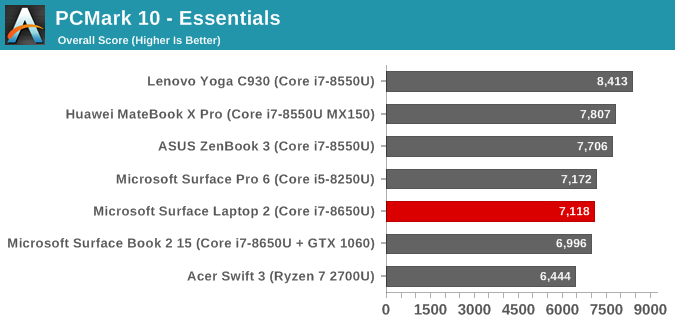
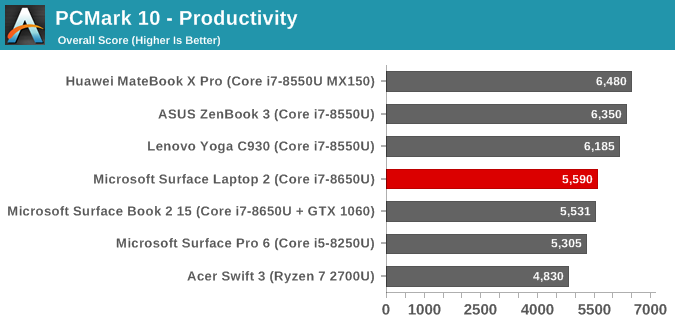

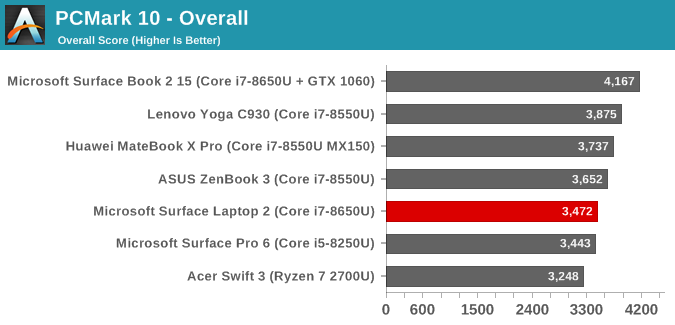
PCMark tests all aspects of a system’s performance level, from graphics to storage. The Surface Laptop 2 is mid-pack with the Core i7-8650U inside. The integrated GPU holds it back in the digital content creation score a bit, but overall it does about what you’d expect from an Ultrabook.
Cinebench
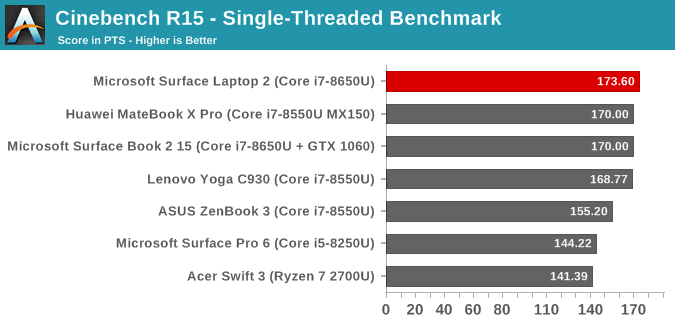
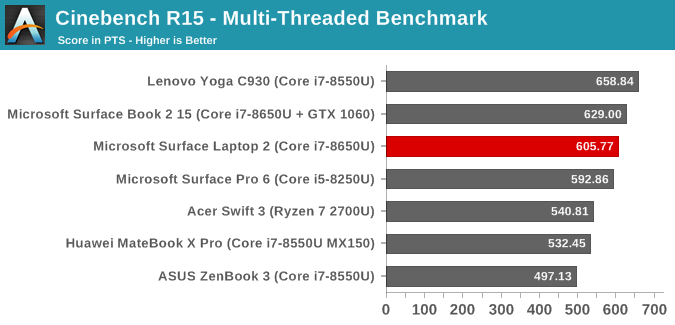
We’ve just got word that Maxon has updated this tried and true benchmark to R20 so we’ll be slowly moving to that updated version in the near future, but since we have back-data from the previous version that’s what we’re using today. The Core i7-8650U tops out at 4.2 GHz which helps a lot in the single-threaded result, and the Surface Laptop 2 holds its own in the multi-threaded test as well, although the Lenovo Yoga C930 is well ahead thanks to Lenovo offering a higher PL2 than we’ve seen on any other laptop.
x264
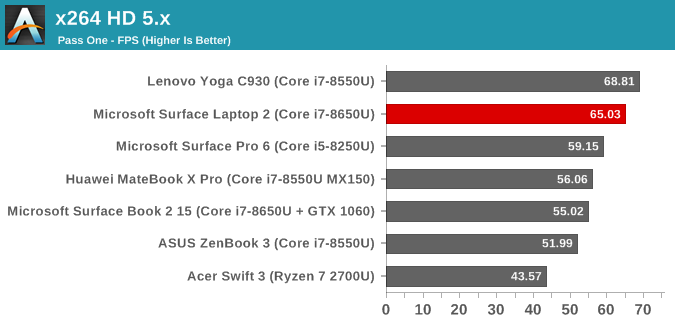

The x264 test is a very long benchmark running four times in a row and can easily take an hour to complete. As such it’s a great test to see CPU performance on a heavy load which will max out the cooling. Microsoft’s Surface Laptop 2 performs quite well here.
Web Results
Browser performance is a major factor in any web-based scripting, and we can see performance scores on the same device change dramatically over time as browsers are updated. Usually the performance trend is upwards, but not always. We standardize on Microsoft Edge for browsing tests.
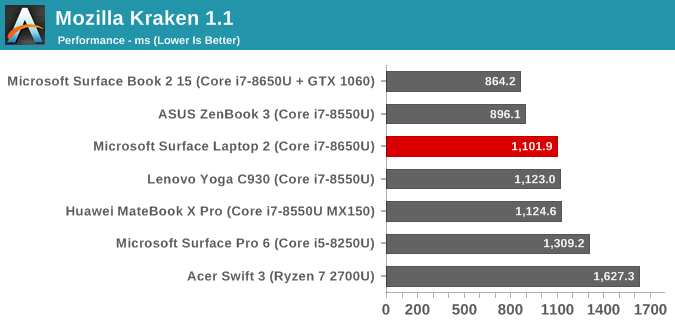
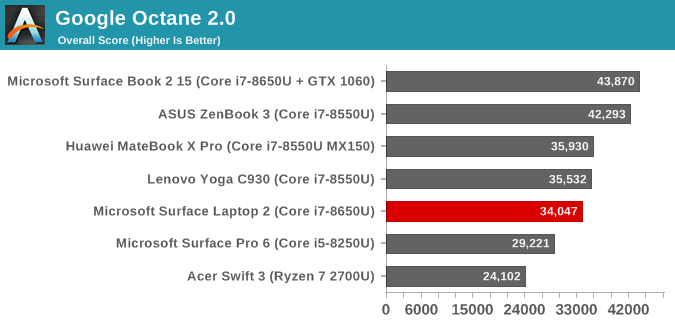
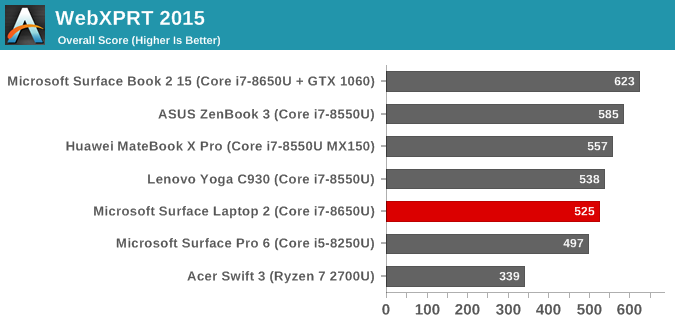
This is one area where Intel tends to hold a lead over AMD thanks to Intel’s work on Speed Shift, which lets the CPU ramp up to maximum much quicker, and that’s important in web results because web workloads are so short. The Surface Laptop 2 with its Core i7 is more or less in-line with the rest of the Core i7 models, where you’d expect it to be.
CPU Conclusion
The Surface Laptop 2 will offer significantly more performance than the original, thanks to the move to quad-core Kaby Lake Refresh. As you can see from the above results though, there’s not a lot of performance difference between the devices which tend to share a common platform underneath. Manufactures just need to make sure they offer enough cooling, and the Core i7 does the rest.


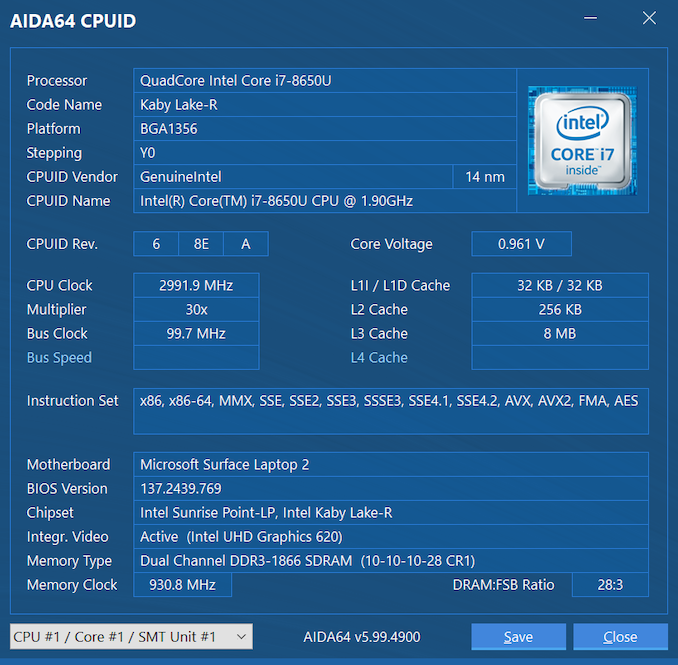








59 Comments
View All Comments
sorten - Thursday, March 28, 2019 - link
If I absolutely needed a laptop today I'd probably pick up a used one so I could wait for the Ice Lake CPUs from Intel this fall. It would be a shame to buy such nice hardware only to find yourself two significant generations behind within 6 months.yankeeDDL - Thursday, March 28, 2019 - link
I hope you're right. Intel has been caught sleeping, and the improvements since SkyLake have been, frankly, anecdotal. It seems that AMD, by making a small core, designed from the ground up to work in tandem with other cores, has a much more effective/scalable architecture. So a 4-core, 8-thread CPU from AMD, while providing slightly lower IPC, today, is much more effective than a 4-core, 8-thread CPU from Intel.Let's see if ICL brings real benefits. The 10nm node should help a lot.
smilingcrow - Thursday, March 28, 2019 - link
"So a 4-core, 8-thread CPU from AMD, while providing slightly lower IPC, today, is much more effective than a 4-core, 8-thread CPU from Intel."I thought AMD currently has lower IPC + lower clock speeds so how exactly are they more effective?
With Ryzen3/Zen 2 due in the summer this may change but for now AMDs advantage is more cores per buck.
niva - Thursday, March 28, 2019 - link
I'm assuming he meant in terms of price/core, but that's just a guess.Doesn't AMD have a big problem with power consumption in mobile CPUs though? I've read that the AMD laptops out now suffer from big power drain even if performance wise they're equivalent or batter than the Intel chips at the same price range.
Irata - Friday, March 29, 2019 - link
Supposedly in idle only, but I do not really see that on my Matebook. Then again, I do not let it sit idling for hours on battery since it boots so quickly that there is no reason for that.In normal use (web / video), the battery indicator does not move much at all.
What many forget is that even with Intel based laptops, there are sometimes big differences between models or manufacturer, depending on the battery size and how well they configured their laptop. The ones that aren't well done are not the ones you usually see in comparison tests though (as there are more models to pick from vs. AMD based ones).
lightningz71 - Monday, April 1, 2019 - link
Their big problem was definitely low power states management on the 2X00u series of chips. The 3x00 series chips that are now hitting the market make up a lot of ground in that regard, both with the chips themselves and better bios/uefi implementations by the vendors that are building the systems. Add in the fact that AMD has finally decided to take the lead on providing a stable, performant drivers for the video section of the chips, and you can largely ignore the abysmal efforts of the vendors themselves to provide quality, updated drivers themselves.For the money, some of the low end AMD 2x00u series laptops gave you MUCH more bang for your buck than the equivalent intel based offerings. The few limitations that people who purchased them did come across could be overcome through software tools by those that it actually mattered to (power and performance management profiles could be tweaked by certain software tools that allowed systems to maintain higher boost states longer and better manage their thermals).
I can't wait to see some of the more thorough write-ups on the latest 3x00h series laptops that are fast enough in both core performance and graphics performance to go up against comparable intel based machines that also include an Nvidia MX1xx series dGPU with an i5. They should technically be less expensive, offer similar performance and be more power friendly when pushed to their limits. This isn't to say that they won't have their flaws, just that, dollar for dollar, on the low end, you'll get more with the AMD system.
Manch - Friday, March 29, 2019 - link
Superior SMTsmilingcrow - Friday, March 29, 2019 - link
IPC includes the whole chip performance so they are still behind.Zen currently makes sense to me if you want 8 or more cores so hopefully with Zen 2 they will compete from 4 cores upwards.
Manch - Monday, April 1, 2019 - link
IPC refers to the perf of a single core usually. Generally has an advantage of about 8-10%. That advantage disapears when using SMT/HT. AMD has the more efficient design so it makes up for that 10% deficit. Throw in multiple core and it starts to win. TBS even now a lot of software is optimized still for Intel but thats changing rapidly. Intel still has a clockspeed advantage. Where as Zen has a pretty hard wall @4.3, Intel can get on down the road a good bit faster. Especially with 4 core chips. I dont think that advantage will last too much longer. Between the mitigations from ME/SPec, and lack of new architecture, Intel seem to be pushing cores over HT now to keep its advantage short term. AMD put out a competitive chip, Intel has yet to fire back like it did with Core against Athlon XPs(Those were the days!) Theyre just stretching their long in the tooth Core. Something is waiting in the wings though.smilingcrow - Monday, April 1, 2019 - link
From what I've seen a 6C/12T Intel beats a similar spec AMD easily.I've read that AMD's HT gives a bigger boost than Intel's but that still isn't enough for it to catch up due to it being too far behind in other areas.
So it's about as meaningful in the real world as a purely synthetic benchmark.
That should change soon with Zen 2 so there will be no need to live the life of a fantasist then.